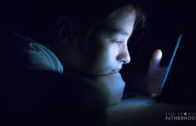Screens & Kids – A Radical Vision of Balance
Podcast: Play in new window | Download
Subscribe: iTunes | Android | RSS
Obviously, it is really tempting to want to give our phones and tablets to our kids because it gives them the perfect babysitter. They are completely taken care of and we can go on and have our adult conversations and do what we need to do. Parenting is so hard that we need breaks and so sometimes we have to do it, but in my cost benefit analysis, devices actually lead to more work on the parent’s part in the long term.
One of the best things that my wife and I decided to do when our child was quite young was to not allow her to use to any of our devices. We saw how many parents were struggling with their kids around access to their phones or tablets, and we didn’t want a child who sat at the restaurant on our phone, separate from us and the world around her. It wasn’t an easy path, but the results have been well worth it and in the end I think a lot less work for us.
A number of very famous people have chosen the same decision. Steve Jobs restricted his children’s access to devices, as did Chris Anderson, the founder of Wired magazine. They read the research about how detrimental it is for children, but I’ve also heard them say they have a hard time hiring people who can think creatively. There are plenty of people who can use computers, but that engaging them at too early an age stops a child from learning how to think creatively for themselves. (Read more here.)
Another such professional was the founder of Broderbund Educational Software. Even though he’d spent his life developing products to help educate kids on computers, he saw that it was better for his kids not to use those computers and, instead, they supported their kids to find other ways to inhabit themselves and self-soothe.
So here are four things that you can do to support your child to have a device free life. Advice varies greatly depending upon your children’s age. Although these guidelines are designed for kids under about ten, they can easily be adapted and loosened if yours are older.
Step 1: Just Say No
The first one is obvious, but can seem impossible. Just say no. If you start young enough, it can be really easy. If on the other hand you are already several years in and they are used to having access to your device, it is difficult, but simply set the boundary. Tell them, “We have one more week and then we are going to stop using devices when we are together.” They will protest and be upset, but once it is initiated, it will only be a few days of protest before they accept the limit and start to find a new way to be in the family. This adjustment period is full of discomfort, but I can’t tell you how enjoyable the result is.
Step 2: Say Yes to Connection
The downside and really the upside is that we do have to be more available for our children if we are not going to pawn them off to devices. But that does not actually mean that we have to spend a lot more energy. Like I said, in my experience it actually leads to a child that needs less and struggles less with us.
They don’t need a lot of attention, but they do need focussed attention. This can be so hard in our current busy world. My favorite way to do this is to simply set a timer and completely give my attention to my child during those 10 minutes. I play with her however she wants to be played with. Following her lead and not bringing in my own agenda. Since it’s for only 10 minutes, I am able to keep the to-do lists at bay and just do the silly game over and over.
When you feed your child with good attention, then they learn to self-soothed and take care of themselves for longer periods of time. Yes, when they ask for attention it requires you to have to turn away from what you are doing. It is hard for me in that moment to turn away, but I am constantly reminding myself that my daughter will not be wanting my attention for very long. Every time she reaches for me and I am in the middle of something that seems really important, I do my best to simply turn away from that task and give her the attention, literally telling myself this may be the last time she ever wants to play in this way.
Step 3: Unplug Yourself
It sucks that what we model matters so much, particularly since it’s so hard to unplug in our current world! If we are on our devices around them, then they aren’t getting somebody to interact with them and they are going to need someway to entertain themselves. Since they see us always getting lost in our devices, they will reach for what they have been shown.
If on the other hand we are not on our device either, then we can be there to play with them, color with them, chat with them and laugh with them. We as humans are greatly fed by human contact, particularly when we are a child. Every moment that you have to be there and pay attention to your kid is like the greatest nectar for them and more likely to lead them to have a happy life. Of course we can’t always be great parents and there are plenty of times when I can’t give my daughter the connection she desires. But whenever I can, I just turn off my device and turn towards her and be present for that precious moment.
Step 4: Protect Your Kids
So many companies say that their products are good for our kids, but a lot of the research has actually shown many of those software programs and devices are not nearly as good for our kids as playing in the trees, or even playing with Legos or jacks. Some of them are helpful, but be skeptical about all the advertising and money that is behind these products.
Conclusion:
To be clear, I am not saying to never allow your child to use a device. We live in a world full of devices, but think about when it is actually age appropriate. Maybe when they are seven, eight, or nine. Some people wait even more. It depends on your child and your situation.
When you do decide to give your child access, I highly recommend making sure to protect them. As a psychotherapist, I can’t tell you how many clients I have who are addicted to online pornography as a result of finding it on their parent’s computers when they were a teenager. You can watch this video to find out more: Porn! Are Your Kids Protected?
And I do recommend continuing to protect your meal and family time and even short drives even as they become teenagers.
Thank you for joining me for another episode. I would love to hear your thoughts about our modern devices. Please join the conversation below and I will see you next time for another episode.
Take care,
Julian















